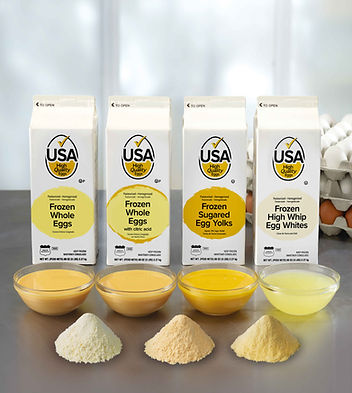Dried Egg Products
Usage
Ingredient especially for the commercial food processing industry.
Availability
Foodservice - 6 oz pouches, 3 and 25 lb poly packs.
Commercial - 25 and 50 lb boxes, 150, 175, and 200 lb drums.
Advantages
Long shelf life, stable and mixable.
Processing Overview
Shell eggs are washed, rinsed, sanitized, candled, broken, separated by automation, and monitored for quality and imperfections.
Liquid whole eggs and yolks are clarified, filtered, and pasteurized using high-temperature, short-time (HTST) pasteurization equipment. After pasteurization, they are spray dried.
The separated egg whites and egg yolks from the same production batch may be recombined in their entirety and identified as whole eggs.
Egg whites are treated prior to drying to remove naturally occurring glucose and preserve color once dried, resulting in stabilized egg whites for longer storage. Glucose is sometimes removed from whole egg and yolk products for long storage stability.
Egg whites are more sensitive to heat coagulation. They are clarified, filtered, glucose removed, and spray dried prior to pasteurization in a “hot room” maintained at a temperature of at least 130ºF (54ºC) for a minimum of seven to ten days. Industry practice often exceeds the required pasteurization regulations — pasteurized at a higher temperature — to improve gel strength.
This assures kill of Salmonella if the moisture content of egg solids is kept at approximately 6%. The whipping ability of egg whites also improves when stored in the hot room at low moisture levels.
Pan drying, which creates a flake or granular product, is another possible method for drying egg whites, but spray drying is generally used because quick exposure to very high temperatures prevents color and nutrient damage.
Added Ingredients
Sugar (sucrose), glucose-free corn syrup, or sodium silicoaluminate are sometimes added according to suppliers’ specifications, as anti-caking agents to assure a free-flowing product. Without these agents, the egg powder could harden and solidify — making it difficult to incorporate into food applications.
Whipping additives like sodium lauryl sulfate may be added to dried egg whites at a level of less than 0.1% (by weight of the liquid prior to drying) to assure whipping ability and aeration properties.
Carbohydrates can be added to increase the egg’s resistance to heat damage, e.g., less protein denaturation during drying and improve stability and flowability of dried egg products.
Storage/Handling
Store dried eggs as any other dried, powdered food in a cool, dark place. Once reconstituted, use immediately or store refrigerated for no more than four days.


Products:
-
Whole eggs or yolk solids
-
Dried egg or scrambled egg mix
-
Egg whites
-
Free flowing whole eggs or yolk solids
-
Stabilized (glucose-free) whole eggs or yolk solids
-
Blends of whole eggs and/or yolk with carbohydrates



